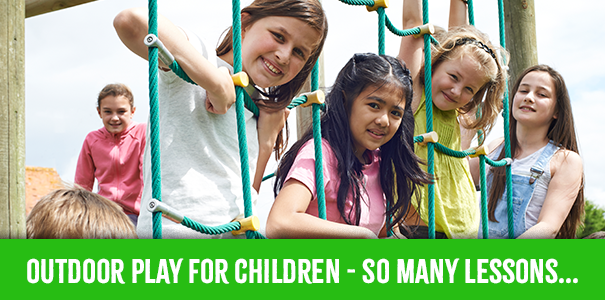Outdoor play for children – so many lessons to learn…

A recent study in the United Kingdom found that on average, children aged 10 to 16 now spend only 12.6 minutes a day on vigorous outdoor activity compared with 10.4 waking hours being relatively motionless. These statistics would be understandable where lockdowns restrict activities in parks, playgrounds and the outdoors.
Sadly, these statistics were before the COVID pandemic. It is fair to assume that motionless hours are a higher proportion of teen life at the moment.
Teens are not the only ones affected by lockdowns and lack of outdoor play. Young children are also affected.
As the value of land increases, town planners appear to favour new, high-density housing estates that have less open spaces for kids in cities to play in a big backyard. Whilst these new estates do incorporate structured shared space, this is not accessible if the Local Government Area is locked down in a pandemic.
When both parents are in the workforce, childcare becomes the responsibility of grandparents, neighbours, friends or paid providers, such as childcare centres, Early Learning Centres (ELC) and Out of School Hours Care (OSHC).
If grandparents are the primary caregivers, outdoor play may be subject to their fitness/mobility, availability and locality.
For the purpose of this article, we will focus on ELC and OSHC services, as they are becoming more prominent in schools, particularly with the inclusion of purpose-built nature/outdoor areas.
The Education Standards Board in South Australia states that “approved providers must ensure outdoor spaces at their services allow children to explore and experience the natural environment. Outdoor natural play environments should provide a blend of natural areas, environmental features and plants to interest children in learning about nature and its elements. Important features include unstructured spaces and activities for creative learning and spontaneous play. Natural environments provide opportunities for children to understand and respect the natural environment and the interdependence between plants, people, animals and the land.”
For children, play is learning and there is no better space for kids to learn than the outdoors, and there is no better play resource than nature.
Imogen Whittle of Nature Play Queensland notes: “Nature play is any activity that gets children active or thinking actively outdoors, with the end goal of building skills and ability to play without the need for parental or adult control. This can be in any setting, so long as it’s outdoors. It supports children being left to their own devices while caregivers supervise from a distance.
Nature play significantly improves all aspects of child development – physical, cognitive, social and emotional.
Playing outdoors grows resilience, self-confidence, initiative, creativity and more. It encourages the joy of movement; it nurtures wild imaginations, experimentation, friendships, social connections and behaviour.”
The number of preschools pursuing learning through nature play is growing fast worldwide. The IEU is aware of a number of non-government schools in South Australia planning, building or operating ELCs with nature play/outdoor areas for this very purpose.
Recent research shows nature play is a highly effective way of embedding STEM — science, technology, engineering and mathematics — in early childhood education. These areas share connections and practices, and research increasingly shows that “regardless of ability, young children are ready, willing, and able to engage in STEM activities”.
Not only do the children learn, educators became active co-learners alongside children, rejecting the traditional perception of teachers as the source of all knowledge. To make the most of STEM opportunities in nature play, educators must understand their role as curious “scientists in action”. They problem-solve, investigate and discover alongside children.
In real terms, children learn science in nature play long before they get to school classrooms and labs. Their environment may not be a public park or big backyard, where their parents played, but the learning outcomes are still there to be enjoyed.
If you work at an ELC in your school, share this article with non-members and remind them that the IEU is the ideal support for their workplace.
Sources
https://natureplayqld.org.au/blog/nature-play-in-early-years-education
https://parentingscience.com/benefits-of-outdoor-play/
https://www.esb.sa.gov.au/resources/outdoor-learning-environments-best-practice-principles
https://aifs.gov.au/cfca/publications/changing-role-grandparents

